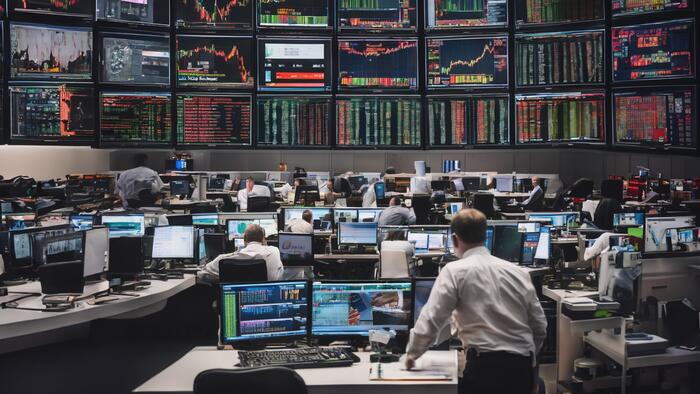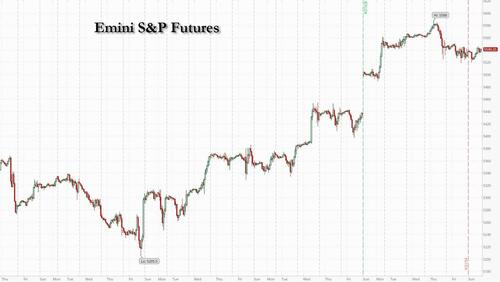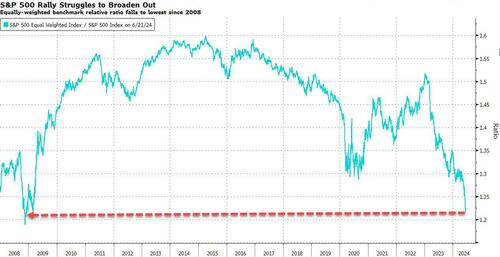


Futures are flat, set for a muted open after erasing an earlier drop, and trading at record highs after three straight weeks of gains ahead of key inflation data later this week and the first debate between Joe Biden and Donald Trump, as well as the first round of the French snap elections. At 8:15am, S&P futures were unchanged while Nasdaq futures dropped 0.1% pressured by a 3% fall in Nvidia, which was set to extend losses for a third consecutive session, and poised to wipe out another $70 billion in market capitalization after news that ByteDance and Broadcom were discussing collaborating on a potential AI superprocessor. Bond yields are higher, and the Bloomberg Dollar Spot Index falls 0.2% after a five-week rally. Over the weekend, macro catalysts were relatively quiet. Oil prices have calmed after a drop last week, while iron ore futures sunk amid further fears about a recovery in the Chinese property market. Bitcoin tumbled on a report the MtGOX trustee will begin $9 billion in repayments in July. This week, traders will be focused on the release of the Fed's favored inflation gauge, the core PCE, which is expected to show the slowest advance since late last year and open the door to possible interest rate hikes. Other key events include the first presidential debate on Thursday and earnings from Fedex (Tue), Micron (Wed) and Nike (Thu).
In premarket trading, megacap tech are mixed: GOOG/L +19bp, META +85bp; meanwhile, NVDA -96bp, TSLA -30bp; MU +68bp ahead of Wednesday’s earnings. Among single stocks, ByteDance and Broadcom have discussed a potential collaboration on an AI processor to help bolster the TikTok parent’s development of that technology Reuters reported. Here are some other notable premarket movers:
According to the latest Bloomberg Markets Live Pulse survey, the gains for the S&P 500 this year have likely peaked, with investors growing increasingly nervous on rich valuations in the stock market. One of the driving forces of the rally, Nvidia, is the most expensive stock in the index now. However, analysts and executives are struggling to quantify what its sales will actually be given the AI boom, making it hard to calculate whether the shares are pricey or not.
While the market’s narrow breadth is concerning to some, others expect the second half of the year to see equities supported by falling rates and strength from earnings.
“Macro indicators show there was broad economic growth in the second quarter and that should translate into earnings growth,” said Patrick Armstrong, chief investment officer at Plurimi Wealth LLP. He expects this will lead into a broadening of the rally.
Meanwhile, the economy’s neutral rate — the theoretical level when borrowing costs neither stimulate nor slow growth — looks to be much higher than policymakers are currently projecting. Later this week, the Federal Reserve’s key inflation gauges will offer clues over the direction of monetary policy.
“With CPI and PPI having been better behaved recently, it is reasonable to expect PCE to continue this narrative of inflation slowly coming down,” said Wei Li, global chief investment strategist at BlackRock Investment Institute on Bloomberg TV. She expects two cuts this year.
“The expectation is we will see confirmation that inflation has slowed and that’s a development the Fed should welcome. If we get more soft inflation prints, they could well signal over the summer they will cut rates in September,” said Lee Hardman, a strategist at MUFG Bank Ltd.
Europe's Stoxx 600 Index gained 0.4%, led by auto shares which benefited from news that China and the European Union have agreed to start talks on the bloc’s plan to slap tariffs on electric vehicle imports. Eurofins Scientific SE plunged as much as 24% in Paris after the laboratory-testing company was targeted by Carson Block’s Muddy Waters Research.
Earlier in the session, Asian stocks fell, led by declines in tech shares, as risk-off sentiment prevailed ahead of key US inflation data this week that may shape the path of the Federal Reserve’s monetary policy. The MSCI Asia Pacific Index dropped as much as 0.6%, slipping for a third session. TSMC and SK Hynix were among the biggest drags. Benchmarks in Taiwan and mainland China dropped the most, while Japanese stocks bucked the region’s slump as the yen’s recent decline supported exporters.
In FX, Bloomberg’s dollar index eased about 0.2%, having enjoyed a five-week rally. The other notable currency mover was the yen, which saw sharp moves around the 160 mark as Vice Finance Minister Masato Kanda said authorities are ready to intervene to support it 24 hours a day, if needed. The pair USD/JPY traded down 0.3% at 159.25 after touching 159.92 earlier
“In the event of excessive moves based on speculation, we are prepared to take appropriate action,” Masato Kanda, the nation’s top currency official, said “The market appears to be becoming less afraid of intervention now given the steadiness of the upside pressure on USD/JPY in the past two months,” Alvin Tan, head of Asia FX strategy at Royal Bank of Canada in Singapore, writes in a note. “I remain doubtful that there is a firm red line for Tokyo on USD/JPY, and new highs above 160 beckon”
In rates, Treasury yields are higher with US 10-year yields flat just shy of 4.27%. French government bonds rise, outperforming their German peers and narrowing the 10-year yield spread by ~3bps ahead of France’s snap legislative election on Sunday. Marine Le Pen’s far-right National Rally has made further gains, according to Bloomberg’s poll of polls. Options market signals that volatility on French vote is likely to last.
In commodities, oil prices advance, with WTI rising 0.5% to trade near $81.10 a barrel. Spot gold rises ~$6 to around $2,328/oz. Iron ore falls over 2% to the lowest since April.
Bitcoin and Ethereum continues to slip, with the pair both at session lows; BTC looking to test USD 61k to the downside after reports that the Mt. Gox Trustee would start Bitcoin & Bitcoin Cash repayments in July.
Looking at today's calendar, US economic data slate includes June Dallas Fed manufacturing activity at 10:30am. Ahead this week are consumer confidence, final 1Q GDP revision, durable goods orders, personal income/spending (with PCE deflators) and University of Michigan sentiment. Fed officials scheduled to speak include Goolsbee (8:30am) and Daly (2pm)
Market Snapshot
Top Overnight News
A more detailed look at global markets courtesy of Newsquawk
APAC stocks were predominantly subdued heading closer to month-end and US PCE data later in the week, with sentiment not helped by Friday's mixed performance stateside and the lack of major macro catalysts. ASX 200 was led lower by the resources and mining-related sectors amid softer underlying commodity prices. Nikkei 225 initially swung between gains and losses as participants digested currency weakness and renewed jawboning but eventually bucked the overall trend owing to exporter strength. Hang Seng and Shanghai Comp. declined whereby the former retreated beneath the 18,000 level amid tech and property-related pressure, while the mainland index continued its descent after it recently breached the 3,000 level to the downside to print its weakest level since late February.
Top Asian News
European bourses, Stoxx 600 (+0.5%) are entirely in the green, having initially opened on a tentative footing. Sentiment improved as the session progressed, though was then capped by poor German Ifo data, with indices currently just off best levels. European sectors hold a strong positive bias; Autos the clear outperformer, benefitting from EU/China consultations on EV tariffs. Retail is found at the foot of the pile, hampered by losses in Zalando (-6.6%), after a broker downgrade. US Equity Futures (ES +0.2%, NQ +0.2%, RTY +0.3%) are entirely in the green, with sentiment lifted in tandem to a pick-up in European equities. In terms of pre-market movers, Broadcom (+1.4%) gains on news that it is working with Bytedance to develop an advanced AI processor.
Top European News
FX
In fixed income
In commodities
Geopolitics: Middle East
Geopolitics: Other
US Event Calendar
Central Bank Speakers
DB's Jim Reid concludes the overnight wrap
The French election on Sunday (part one) will be the main event this week with some indication of how it’s gone as we go to print this time next week. The opinion polls over the weekend generally saw the far-right National Rally party continuing to see their support edge up with the latest poll of polls showing support at 33%, versus the 27% for the far-left New Popular Front (NPF) and 20% for Macron’s movement. As an interesting aside one of the NPF members Eric Coquerel, who was chair of the finance committee prior to the dissolution of parliament two weeks ago, said that his party's alliance would raise the top marginal rate of income tax to 90% if it were elected. The top rate is currently 45%. While the constitutional court may well prevent this if they were in power, it is more evidence of the potential consequences of this election.
Staying with politics, it will also be fascinating to see the first televised debate between Biden and Trump on Thursday evening in the US. There is plenty of scope for big headlines and for the candidates to gather some momentum or see it go into reverse.
In terms of data the main event is Friday's US core PCE. Friday is a big day for inflation elsewhere as the European flash CPI is out after Tokyo CPI in Japan earlier in the day.
Other highlights this week by day are the German IFO today; US consumer confidence, Japan PPI, Canadian CPI tomorrow; US new home sales, Australia CPI and a 5yr UST auction on Wednesday ; US trade, durable goods, and a 7yr UST auction on Thursday; and with Friday bringing German unemployment, and the final UoM US consumer sentiment alongside the inflation data mentioned above. The day-by-day calendar at the end gives a fuller dairy of events.
Previewing Friday's US core PCE deflator, our economists' believe it should increase +0.17% (vs. +0.25% previously), which would have the effect of lowering the year-over-year rate by 12bps to 2.63%. One note of caution is that their estimate does not include the -10.2% plunge in the seasonally-adjusted PPI for international scheduled passenger air transportation. Their estimate would be about 5bps lower if the BEA does not smooth through this drop. Thus, risks are skewed to the downside which is certainly one to watch.
Moving on to European inflation, our European economists' inflation previews Friday's flash releases here.They expect Eurozone HICP to come in at 2.40% YoY (2.57% in May). Across countries, their forecasts are 2.4% (2.8%) for Germany, 2.5% for France (2.6%), 0.8% for Italy (0.8%), and 3.4% for Spain (3.8%).
Another thing to watch is Nvidia and tech. Nvidia became the largest company in the world on Tuesday night before Wednesday's holiday. It then opened over 3% higher on Thursday. However from this peak it fell around -10% into Friday's close. Is this a brief hiccup, or the start of some air being let out of the ballon? Interestingly our very prescient equity strategists have put out a note over the weekend arguing for a breather in US markets partly due to stretched positioning and a buy back black-out starting next week ahead of Q2 earnings. See their note here.
Asian equity markets are mostly trading lower this morning, with Chinese markets leading losses with the Hang Seng (-1.03%) emerging as one of the biggest underperformers while the CSI (-0.38%) and the Shanghai Composite (-0.67%) are also trading lower. Elsewhere, the KOSPI (-0.89%) is also nursing losses with the S&P/ASX 200 (-0.76%) also falling. Meanwhile, the Nikkei (+0.62%) is bucking the trend. S&P 500 (-0.11%) and NASDAQ 100 (-0.08%) futures are slightly lower.
On China-EU tariffs, trade chiefs from both sides discussed the topic on a call over the weekend and agreed to hold further consultations in the coming weeks. Provisional EU duties of up to 38.1% on imported Chinese-made EVs are set to kick in by July 4 with the tariffs set to be finalised on November 02 at the end of the EU anti-subsidy investigation.
Earlier this morning, the BOJ’ summary of opinions from its June monetary policy indicated that board discussed the possibility of raising interest rates further amid concerns over lingering inflationary pressure. Meanwhile, the Japanese yen is fluctuating in a tight range, trading fractionally higher (+0.08%) to trade at 159.66 against the dollar but is still near its weakest level in 34 years even after more verbal warnings from the top currency official Masato Kanda where he emphasised that authorities stand ready to intervene in currency markets 24 hours a day if necessary.
Now recapping last week, the S&P 500 gained +0.61%, supported by solid data releases earlier in the week, although the index slipped -0.16% on Friday. Last week’s rally was broad based, with the equal-weighted version of the S&P 500 rising +1.12% (+0.12% on Friday) and the small cap Russell 2000 gaining +0.79% (+0.23% on Friday). On the other hand, the tech-heavy NASDAQ was flat on the week (-0.18% on Friday). Nvidia led the tech underperformance, falling -4.03% (and -3.22% on Friday). The semiconductor giant briefly overtook Microsoft to become the world’s most valuable company on Tuesday, before falling back into third place at the end of the week after a difficult couple of days after Wednesday's holiday.
The performance of US equities was subdued on Friday even as the June flash PMIs came in better-than-expected. Most notably, the flash services PMI rose to 55.1 (vs 54.0 expected), its highest level since April 2022. The manufacturing PMI also improved to 51.7 (vs 51.0 expected), bringing the composite index to 54.6 (vs 53.5 expected). This activity improvement came even as the composite output price index eased to a 5-month low of 53.5 (vs. 54.3 prev.), so the release was firmly on the soft landing side of the ledger.
The moves in European and US markets were more in line last week as the political uncertainty originating in France was better digested by markets. European equities made decent gains, with the STOXX 600 up +0.79%. The index did sell off on Friday (-0.73%), driven mostly by weaker-than-expected flash PMIs for June. The euro-area composite PMI fell to 50.8 (vs 52.5 expected), ending a run of 5 consecutive monthly gains. The story was similar for the national equity indices, as the CAC 40 and DAX rose +1.67% and +0.90% last week respectively despite a sell-off on Friday (-0.56% and -0.50%). Elsewhere, the MSCI EM index rose +0.93% (and -0.81% on Friday).
Whilst equities recovered, bonds struggled last week. The 10yr Franco-German spread widened +3.1bps on Friday (and +3.4bps last week) to 80bps, its widest since 2012, after the French left-wing alliance announced aggressive spending plans ahead of the French election. Against this backdrop, sovereign bonds lost ground across the board. 10yr bund yields rose +4.9bps, despite a -2.3bps decline on Friday following the weaker PMI release. 10yr OAT (+8.3bps), BTP (+1.2bps) and gilt (+2.7bps) yields were also higher on the week. Over the Atlantic, 10yr Treasury yields were up +3.5bps to 4.26% (-0.4bps Friday).


